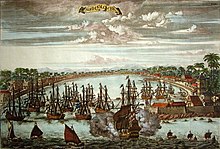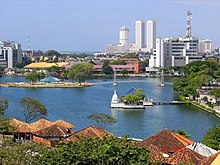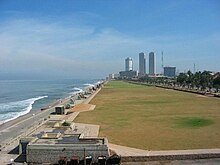Colombo

Colombo (Sinhala: කොළඹ, pronounced [ˈkəlombo]; Tamil: கொழும்பு) is the commercial capital and the largest city of Sri Lanka. It is located on the west coast of the island and adjacent to Sri Jayawardenepura Kotte (which is the official capital of Sri Lanka) suburb or the parliament capital of Sri Lanka. Colombo is also the administrative capital of Western Province, Sri Lanka and the district capital of Colombo District. Colombo is often referred to as the capital since Sri Jayawardenapura Kotte is a satellite city of Colombo. Colombo is a busy and vibrant place with a mixture of modern life and colonial buildings and ruins. It was the political capital of Sri Lanka, before Sri Jayawardenepura Kotte.
Quotes
[edit]
- Colombo is today a vibrant, optimistic city with something for everyone – cheap shopping, fabulous eating options, proximity to the beaches and hills, as well as to the country’s prime Buddhist sites. Plus the city is the hub for one of the major cultural festivals of the country – The Navam Perhera Parade.
- Charu in: Kavitha Rao And Charukesi Ramadurai Everything You Wanted To Know About Freelance Journalism, Westland, 29 January 2014
- "Kolamba" (Anglicised "Colombo") is a Sinhalese word; meaning port, ferry, harbour or haven.
- Julius de Lanerolle, in an article in the Journal of the Royal Asiatic Society, Ceylon Branch, quoted in: Municipal Council of Colombo The History of the City, Municipal Council of Colombo
- As the largest city in Sri Lanka formerly known as Ceylon, Colombo is the financial and commercial capital of Sri Lanka. It has been ruled by the Portuguese, Dutch and British.
- Municipal Council of Colombo in: "The History of the City"
- ...belief is that the name is derived from the Sinhalese name කොල-අඹ-තොට Kola-amba-thota which means "Harbour with leafy mango trees".
- Padma Edirisinghe in: Colombo - then and now, The Sunday Observer, 15 February 2004
- Colombo is a derivative of 'Kola-amba-thota', which means 'mango harbour'. The history of this vivacious city dates back nearly 2000 years, when the Muslims handled trade between Sri Lanka (known as Serendib) and rest of the world. The importance of Colombo was further enhanced when the British conquered the entire island and marked the city as the capital of Ceylon. Although the country's capital city was changed to Sri Jayewardenepura Kotte, many still consider Colombo to be Sri Lanka's capital.
- Executive in: Sri Lanka Hotels and City Guide, worldexecutive.com
- The city of Colombo is today dubbed "The ultimate in our concrete jungles", not at all a complimentary term especially from an environmental point of view. But some four to five centuries back except for the little outcrop of trading settlements (mostly Moor settlements) around Kolon Thota, the area shared the characteristics of the average topography of our island as a showcase of lakes, waterways, marshes, shrubland and even small forests and hills of modest proportions.
- Padma Edirisinghe in: "Colombo - then and now"
- Forests, pachyderms on the run, gushing waterways - just 350 years ago that was the scenario around the present Regal Roundabout where the cinema hall that lent the place its name flashes its latest cinema pieces via giant posters and glitzy neon lights.
- Padma Edirisinghe in: "Colombo - then and now"
- In the 18th Century i.e. in the area where the tall Bank and hotel buildings and the World Trade Centre loom to the skies, it was no doubt another open space by the ocean where the ruling Dutch and the natives gathered for various purposes. After the British captured Colombo from the Dutch they had erected here five blocks of barracks for garrison troops in the year 1875 which complex came to be known as the Echelon Square. But before the capture the area had been known as the Kaffirs Veldt, a term it had earned later due to a hotch potch of turbulent events connected to the Kaffir labour force.
- Padma Edirisinghe in: "Colombo - then and now"

- Colombo is everything I did not expect. It is not your exotic tourist destination, and it is not a place that I would say is celebrating its culture or traditions as much as you’d expect. The look of the city is a mix between your typical overcrowded Asian towns, while the centre towards the port features a series of colonial buildings that clearly show the influences of the past. The past crises, over 30 years of tensions as well as the Tsunami in 2004, have left their mark. However, people are making a huge effort to compete with their Indian neighbours to the North and apparently Colombo has never been as clean as it is now. Many colonial buildings are under refurbishment and there is definitely a wave of excitement, a sense of moving on and becoming a global destination for business and tourism.
- Clare Green, Stefan Siegel in: Colombo: Paradise City?, Not Just a Label, 3 April 2013
- People are said to prefer Colombo City for both residences and businesses...Colombo virtually offers an unlimited resource for further foreign investment.
- Paul A. Groves in: Economic Development and Social Change in Sri Lanka: A Spatial and Policy Analysis, Technical Publications, 1996, p. 87
- The official town planning history attributes the success of the Colombo, 'garden city' plan to Patrick Geddes, casting him in heroic light.
- Anoma Pieris in: Architecture and Nationalism in Sri Lanka: The Trouser Under the Cloth, Routledge, 1 January 2013

- Dutch left a lasting impression in the field of architecture. Dutch period buildings still survive in Colombo, Galle and Matara, bearing ample testimony to the fine tastes and aesthetic sense of the Hollander. The place-names of Dutch origin are not many, but are nevertheless significant, and include Hulftsdorp, which is Dutch for 'Hulft's Village', area once served as the headquarters of the Dutch General Gerard Hulft during the siege of Colombo in 1656. Among the other place-names in Colombo, which are of Dutch origin, may be included Bloemendahl (Vale of Flowers) and Wolvendaal (Dale of Wolves). The Beira Lake in Colombo probably takes its name from De Beer who is believed to have been an engineer in charge of the Dutch water defences. In the far north, the Dutch term Delft given to the island of Neduntivu still survives. The Dutch names given to the other islands of Jaffna such as Hoorn, Leiden, Amsterdam, Rotterdam, Middelburg and Enkhuizen have all but disappeared and have been replaced by their local Tamil names.
- Manawadu Samitha in: Cultural Routes Of Sri Lankaas Extensions Of International Itineraries : Identification Of Their Impacts On Tangible And Intangible Heritage, International.icomos.org
How Did Colombo Derive its name
[edit]

Jayewardene in: How Did Colombo Derive its name ?, rootsweb.ancestry.com
- Colombo derives her name from the Port of Kolomtota (Colombo harbour), which traces back to the Sri Jayawardenapura Kotte kingdom. In 1369, Nissanka Alakesvara, King Vikramabahu III's powerful prime minister, established Sri Jayawardenapura Kotte, which has been the administrative capital of Sri Lanka since 1982. Through centuries of Portuguese, Dutch and British rule, the name was changed to Colombo.
- Kolomtota was the port first used by traders from China and the Far East, India, Persia, Abyssinia and Indonesia, who came to barter for the country's famed spices. In April 1505, however, an epoch of 443 years of foreign occupation began in Sri Lanka, when the Portuguese fleet under the command of Don Lorenzo de Almeida arrived in Colombo's harbour. Soon after, Portuguese rule became official with the signing of a trade treaty with King Parakramabahu the VIII, and it prevailed until 1656. Following the Portuguese were the Dutch, who occupied the country from 1656 to 1796. Then came the British, ruling the region as a colony until a few years after World War Two.
- The first to adopt Colombo as their administrative centre, the Portuguese built forts, stores, barracks, churches and residential quarters. The Dutch then used the city as their operational centre and expanded her borders. The British made Colombo the capital of their new colony and positioned her as a blossoming metropolis of the east.
- Colombo's current centre, Fort, got its name from the presence of the Portuguese and the Dutch fortifications located there. At the turn of the 21st century, the British, who took over from the Dutch after bitter fighting, razed the last structures of the Dutch stronghold. It was the British, however, who left a truly lasting impression on almost every aspect of life in Colombo. They developed a unique urban plan to modernise Colombo, under which specific areas were demarcated for economic, political, judicial and cultural developments. They encouraged the rapid and uninterrupted development of the plantation sector, which in turn presented demand for a banking and commercial shopping complex at Fort.
- Self-administration in 1948, and the following economic development, encouraged skyscrapers to alter the Colombo skyline radically. Stunning hotels and commercial buildings stand out among remnants of the city's architectural past.
History of the City
[edit]

Municipal Council of Colombo in:History of the City, Municipal Council of Colombo
- Colombo was originally a small seaport used by Moor, Arab, Persian and Chinese sailing vessels.
- Following the occupation of the coastal provinces of Ceylon by Portuguese, Colombo became the centre of the Portuguese rulers and after the annexation of Kandyan Territory by the British in 1815 it became the capital of the whole island.
- When the Portuguese arrived in Colombo it was spread round the bay, which was not more than three fathoms in depth where it was deepest. The land between the fortress and the interior was at first unoccupied and covered with trees. The Portuguese were compelled to reinforce the garrison to resist attacks by Mayadunne and Vidiya Bandara.
- The Portuguese occupation of Colombo ended with the siege of 1656 when the Dutch captured the city.
- Centuries of colonial rule saw a decline of indigenous administration and the Ordinance in 1865 which created Municipal Councils to Colombo and Kandy was conceived as a means of training the Ceylonese in the art and science of self-government.
- The Legislative Council of Ceylon, by a Bill constituted the Colombo Municipal Council in 1865 and Council met for the first time on the 16th January 1866. The establishment of the Colombo Municipal Council was perhaps the first substantial step taken by the rulers to give the Ceylonese as a whole the feeling that Colombo was their city and capital.
36 Hours in Colombo, Sri Lanka
[edit]Nell Mcshane Wulfhart in: 36 Hours in Colombo, Sri Lanka, The New York Times, 13 December 2013
- Colombo is fast becoming a draw in itself. This city of 555,000 people has been on fast-forward since a 25-year civil war ended in 2009. Checkpoints have come down, trendy lounge bars have opened up, and the vibe is one of cautious optimism combined with an increasingly cosmopolitan outlook.
- Today, this colorful city on the Indian Ocean, with its laid-back island ambiance, palm trees, decaying colonial buildings and smattering of modern office blocks, is the perfect place to get a sense of where Sri Lanka is going after so many tumultuous years.
- The merging of Sinhalese, Tamil and Muslim cultures [can be seen] in the tightly packed streets of Pettah, Colombo’s main market. Shirtless men in sarongs haul carts loaded with vegetables, electrical goods spill out of shop doorways, and mosques compete with Hindu temples for space. Ayurvedic medicine for what ails you (widely used in Sri Lanka) can be found in abundance on Fifth Cross Street, and jewelry shops, many selling the cut-price gems (sapphires in particular) for which the country is noted, line Sea Street.

- Galle Face Green is broad stretch of lawn [that] borders the ocean on one side and the city’s business district on the other. On evenings and weekends, the green fills up with a cross-section of Colombo citizens, from elderly couples enjoying the sea breeze to groups of scruffy youths playing cricket, and still others strolling, flirting, jogging and flying kites.
- ...algae-laden Beira Lake in the city center, once used to transport goods within the city is now patronized by couples in swan-shaped [[w:Paddle boats|paddle boats.
- The Seema Malaka temple, a meditation center designed by Geoffrey Bawa, Sri Lanka’s best-known architect, known for his signature tropical modernism style. The temple extends from the bank into the lake, an elegant construction of wood and stone with a surfeit of Buddha statues. It’s a peaceful haven in a city filled with honking tuk-tuks and buses blasting Indian pop tunes. An abundance of pelicans and storks call the lake home, and it’s not uncommon to see a yard-long monitor lizard pulling itself onto the banks.
- Colombo’s antiquated yet meltingly romantic trains (with bare-bones interiors and often with surplus passengers clinging to the side) run straight down the coast.


